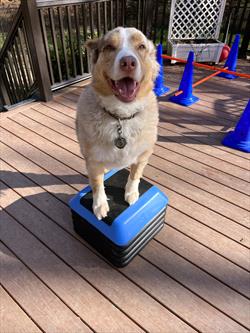Australian Shepherd on stationing stand

Photo of Willy Courtesy Pat Koven, LVT, KPA-CTP
Q: My vet suggested I work on consent training with my dog for his insulin injections. What does that mean?
A: Consent is a hot buzzword in the animal behavior and training world. But what does consent really mean? Consent means your dog is giving permission before allowing something to happen to them. So, if dogs can’t talk, how do they give consent? They do this by offering consent behaviors voluntarily.
Consent training is your pet’s choice and can be used with any animal. This type of training creates a stronger relationship between you and your pet. When freely offered, these behaviors indicate your dog’s trust in you.
Pet owners can use this training for all types of handling:
- grooming;
- giving medications and injections;
- medical procedures and exams;
- nail trims;
- physical therapy;
- massage.
Communication is key with consent training. Your pet can be taught to demonstrate that they are willing participants in whatever comes next. If they do not offer a consent behavior, they are saying no, and this choice must be recognized and honored to keep that trust. If your dog repeatedly says no, then address what might be concerning them, such as a noisy environment or perhaps pain restricting their ability to get into position. It may be that they do not understand what you are asking.
Because dogs do not speak the same language as humans, their consent requires different communication skills than a person might give. You are capturing and shaping known behaviors which can be used as start buttons. When your dog performs the “start”, they are signaling their permission for you to continue with any procedure.
Petting is a common example of when consent should be requested. It is important never to invade a dog’s personal space and always ask them to come to you. If they do, and they are relaxed, you can try petting them along their shoulders and sides, then stop. If they look to you for more, nudge your hand, or lean against you, they are likely giving their permission for you to continue.
You can also use behaviors for consent training that your dog already knows, such as sitting to put on their harness. It is important that your dog always has the option to walk away from these interactions if they need a break. Nose targeting to a cabinet full of grooming supplies could be a cue from your dog requesting brushing.
Your dog can also demonstrate consent with any new behaviors you teach, such as:
- stationing to a mat platform;
- offering a chin rest;
- lying down on their side;
- offering a paw.
Willy chin rest.jpg

Photo of Willy Courtesy Pat Koven, LVT, KPA-CTP
By using consent training, you are providing your dog opportunities to opt-in or out. If they do not perform the start button, give them a break, and evaluate why they may not want the procedure done. Start with simpler procedures and increase the reinforcement value.
By giving them this communication tool, you are giving them choices, minimizing stress, and removing force. They will be more trusting, happier, and likely have fewer behavior concerns.